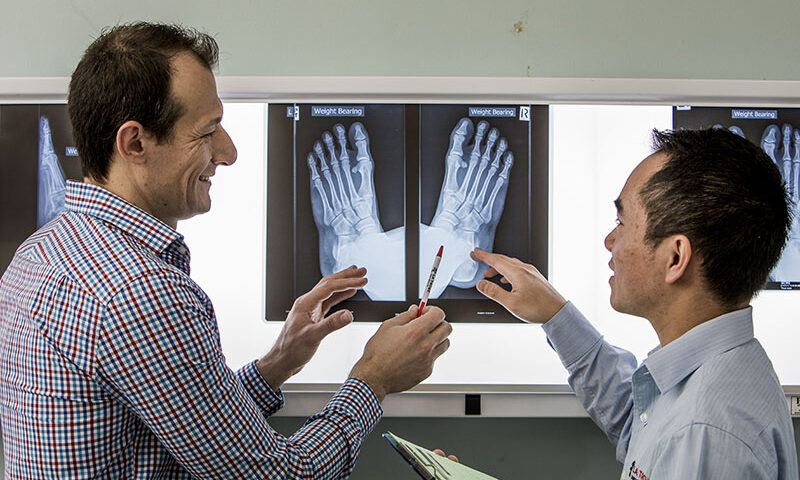
Dental student shares study tips
November 3, 2020
Making her mark
November 5, 2020What the podiatrists say
An interview with Dr Daniel Bonanno – La Trobe University Podiatry Lecturer
Q1. Michelle: Tell us why you became a podiatrist?
Dan: Throughout high-school I always wanted to work in healthcare due to my interests in sport and exercise. Halfway through year-12 I had narrowed down my options to podiatry, exercise science or physiotherapy, but I was still quite undecided. It was around this time that I unfortunately injured my foot quite badly playing football and I ended up seeing my local podiatrist. She ordered x-rays that confirmed I had fractured a bone in my foot, and she then prescribed me with a detailed rehabilitation program, made me a pair of foot orthoses and modified my football boots. It was this firsthand experience that helped me decide that becoming a podiatrist was the perfect fit for me.
Q2. Michelle: Can you tell us a little bit about your experiences as a podiatry student that helped prepared you for your career?
Dan: As a student I really enjoyed learning from experienced podiatrists, researchers and teachers, particularly in the areas of anatomy, sports medicine, paediatrics and foot surgery. Although I really enjoyed these subjects, upon reflection, it was probably the work placements in community health centres, private practices, hospitals and La Trobe’s on-campus podiatry clinic that best prepared me for my career. As I said earlier, I studied podiatry due to my interest in sport and exercise, but through my clinical placements I soon realised that podiatrists can help people of all ages, from young children to older adults, and treat and manage many conditions of the foot and lower limb, including bone and joint disorders, and neurological and circulatory diseases. I really enjoyed my external placements as I was able to see podiatrists working in a large variety of health settings. In fact, I enjoyed my final 2-week student placement so much that I got my first podiatry job there!
Q3. Michelle: Can you tell us a little bit about your experiences working in the field of sport?
Dan: Sure thing. After several years of working in community health I decided to pursue a career in the field of sports podiatry. I reached out to a podiatry friend who I studied with (hello Kath) who was working at a sports medicine clinic, and my timing was perfect as she was moving to England to work as a podiatrist. I was able to step into her position, and over the next few years one thing lead to another and I was soon consulting at two large sports medicine clinics, I worked at the Commonwealth Games, and then became the team podiatrist to the Carlton Football Club and Melbourne City Football Club. I’ve been able to work in many different sports settings, which includes recreational and elite athletes, and I’ve enjoyed all of them.
Q4: Michelle: What else do you do in your typical working week?
In addition to working with the two professional football teams, I have a teaching and research position at La Trobe University. I enjoy drawing upon my clinical experiences in my academic position, where my teaching and research is mainly focused on the prevention and management of lower extremity injuries. In recent times I’ve started a few research projects looking at netball and basketball footwear design, and how they influence the way we move, if they can help prevent injury, and how they affect athletic performance – its only early days but I’m looking forward to seeing where these projects may go. I also work as an Associate Editor for the Journal of Foot and Ankle Research, and I’ve recently become the Victorian Director of Sports and Exercise Podiatry Australia. So, I guess you could say that my working week is quite diverse which is how I like it, and it seems like there is always a new and exciting opportunity just around the next corner.
Q5. Michelle: What do you enjoy most about being a podiatrist?
Dan: Helping people, and I think that’s what most podiatrists would say. In the areas that I work, I get a lot of satisfaction helping people achieve their sporting goals, whether that be to continue their professional sporting career following a serious injury, run a marathon for the first time, or simply return to regular exercise to get healthy. Ultimately, all podiatrists make a positive difference to the lives of their patients, and that is what makes it such a rewarding career.

Podiatry has given Nihal a rewarding career in medicine
An interview with podiatrist Nihal Singh
What inspired you to be a podiatrist?
I am from a household of health professionals, so I was always interested in a career in health and working with people. For work experience in year 11, I spent time with a podiatrist. I was struck by the rewarding nature of the job and I’ve had my heart set on this career path ever since. I attended Open Day at La Trobe University as an eager year 11 student and I learnt even more about the diverse patients that podiatrists treat and the settings in which they can work. I am still feeling inspired by the wonderful world of podiatry!
Can you explain where you currently work?
I currently work at St Vincent’s Hospital in Melbourne within the Podiatry Department and the High Risk Foot Unit. I also work a day per week in research, on a project looking at the role of podiatry to reduce foot complications in adults on dialysis. Patients with kidney disease can often develop foot problems similar to patients with diabetes.
I have been lucky enough to work across most settings, including hospitals and private practices over the past 6 years. I’ve even worked at a prison through my role at St Vincent’s Hospital.
What different roles do you perform as a podiatrist?
Podiatrists play a vital role in foot wound care, pressure care, assessing blood flow, and sensation to the lower limb and foot. I work closely with vascular surgeons, endocrinologists, and infectious disease specialists within the High Risk Foot Unit to provide a team approach to patient care.
Recently, I have been awarded with my endorsement to prescribe scheduled medicines. With this endorsement, I can prescribe medicines such as antibiotics, which comes in handy for the management of patients with infected foot wounds.
What do you enjoy most about working in a hospital?
I love the team environment, the fast-pace, and seeing patients from all walks of life. In my role, I am a strong advocate for conservative treatment options that can be used prior to pursuing surgical interventions.
St Vincent’s Hospital has a wide catchment and I often see patients from rural Victoria during their hospital stay. I can follow these patient’s with telehealth consultations, often working closely with community podiatrists to provide follow-up care.
What sort of patients do you normally treat?
Working in the hospital, I see patients on the wards with foot problems that put them at risk of foot amputation or serious complications. These patients often have diabetes, but not always. At St Vincent’s Hospital we also see people from population groups who are at most risk, such as patients who have had a previous amputation, poor blood supply, reduced sensation or foot deformity that require monitoring and management. As a hospital podiatrist, my aim is to provide efficient patient care in a timely manner so that patients can be discharged and return home.
What do you think are the benefits of working in a hospital setting?
I believe the positives of working in a hospital setting as a podiatrist are the diverse foot presentations, the fast-paced nature of the role and working alongside other medical and health professionals. By working in the hospital setting, I have had opportunities to be involved in research projects and to be supported to become endorsed to prescribe medicines.

Luke combines elite sport and studying podiatry for a winning edge
An interview with current La Trobe student Luke.
What inspired you to be a podiatrist?
I always wanted to work in sport and my involvement at the elite level of athletics has exposed me to various health professionals. Having worked closely with podiatrists both clinically and recreationally helped me learn about the scope of podiatry, and how podiatrists treat injuries of the lower limb and foot. This is what inspired me to become a Podiatrist. Ultimately, having considered a career in physiotherapy, my close collaboration with podiatrists altered my decision.
Tell us about your involvement in sport
I have been fortunate to be involved in a variety of sports such as AFL, tennis, and athletics. I only took-up track & field sprinting in my later teenage years, after some convincing from family and friends, which has led to an ambition to be the best sprinter possible in my own right. I am driven to compete at the highest level the sport has to offer.
You’re an elite athlete, how have you combined sport and study to be a podiatrist?
Honestly, combining sport and study full-time wouldn’t be possible without the support I’ve received from the staff of the Discipline of Podiatry and the La Trobe Elite Athlete Program (LEAP). Being able to adjust assessment due dates and University deadlines around my athletics schedule has been less stressful, as the staff at La Trobe were very supportive of my athletic endeavours and did everything in their power to ensure I was able to maintain my studies to an sufficient standard.
How do you see sport combining with your career as a podiatrist?
As I reflect on my athletics career thus far, I still have major goals that I want to achieve. I want to address these goals first, and hopefully my graduate podiatrist job can accommodate my athletics. I aim to continue competition nationally and internationally, as I know sport at this level doesn’t last forever.
You will be graduating soon, how are you feeling about job prospects?
I’m feeling really confident that I can find a position that can give me the opportunity to commence my podiatry career. At this stage, I have spoken with a couple of clinics who I have encountered through sporting connections. However, given the uncertainty with job prospects in the middle of a pandemic, I will be keeping all my options open.
What has surprised you most about studying podiatry?
The most surprising elements about podiatry are varied roles that podiatrists perform, such as the ability to gain prescribing rights and perform surgical procedures. These roles are unique and are not available to any other allied health professionals. Furthermore, the on-campus podiatry clinic that La Trobe offers has really been a great way to prepare for work as a podiatrist.



